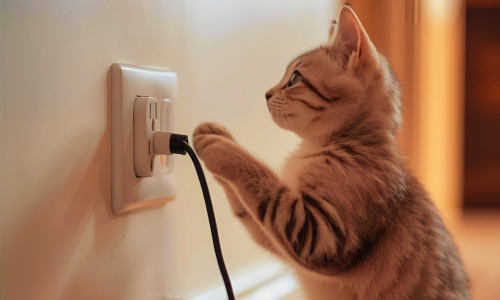Electricity is one of those things most homeowners rarely think about—until something goes wrong. But age, wear, and improper modifications can all lead to safety hazards. That’s why the electrical system is a key part of every home inspection. Ross approaches this portion of the home inspection with the same attention to safety that he brought to years on the fire line—because electrical issues are one of the leading causes of residential fires.
Inside the inspection
Electrical SYSTEMS
What’s Included in an Electrical Inspection
A standard residential inspection focuses on identifying visible defects, safety concerns, and improper installations within the electrical system. Inspectors don’t perform load calculations or open up wiring behind walls, but they do evaluate critical components to ensure they’re properly installed and functioning safely. Here’s what’s included:
Service Entrance and Meter: Inspectors look at how power enters the home and whether the service drop, mast, and meter appear properly secured and in good condition.
Main Panel and Subpanels: The inspector will remove the panel cover (if safely accessible) to examine the condition of breakers, wiring, grounding, and labeling. They look for signs of overheating, corrosion, double-tapped breakers, missing panel covers, or outdated equipment that may not meet current safety standards.
Grounding and Bonding: A properly grounded and bonded system protects against shock and ensures electrical faults are safely directed away from occupants. Inspectors check for grounding electrodes, bonding jumpers, and proper conductor connections where visible.
Branch Circuits and Wiring: Accessible wiring is checked for damage, improper splices, or outdated materials such as aluminum branch wiring. Inspectors also look for extension cords being used as permanent wiring or evidence of amateur modifications.
Outlets, Switches, and Fixtures: Inspectors test a representative number of accessible outlets and switches for proper operation and polarity. They also confirm the presence of GFCI protection in wet areas (kitchens, bathrooms, exterior, garages) and AFCI protection in required living spaces. Missing or malfunctioning devices are noted for safety upgrades.
Lighting and Fans: Fixtures are checked for secure mounting, functional switches, and proper operation.
Ross brings a practical eye to this part of the inspection. He’s seen firsthand how small electrical oversights—like a loose neutral wire or a missing GFCI—can lead to major emergencies. His firefighter background adds weight to each observation.
New Construction Inspections
The pre-drywall inspection lets the inspector see things about the electrical system that simply aren’t visible at other times. Without the obstruction of drywall, the hidden wiring in void spaces can more closely inspected and homebuyers can receive documentation for how wiring is run throughout the home.
Beyond the Basics
While inspectors don’t perform in-depth electrical diagnostics, this is an area where professional judgment really matters. Ross often identifies:
Overcrowded Panels: Older homes frequently have panels that were never designed for modern electrical loads, with too many circuits jammed into a small space.
DIY Wiring: Homeowner modifications can range from mildly unsafe to outright dangerous, including reversed polarity, improper splices, or overloaded circuits.
Outdated Equipment: Panels like certain Federal Pacific or Zinsco models are known for safety issues. Identifying these early can save buyers from costly—and necessary—electrical upgrades later.
Catching these issues before they cause a failure isn’t just about convenience—it’s about safety.
Why It Matters in Texas
Electrical systems work hard in Texas homes. Between extreme heat driving heavy HVAC use, growing reliance on large appliances, and frequent storm activity that can stress systems, proper wiring and protection devices are essential. A thorough electrical inspection helps ensure the home’s system can safely handle modern demands for Austin area residents.


